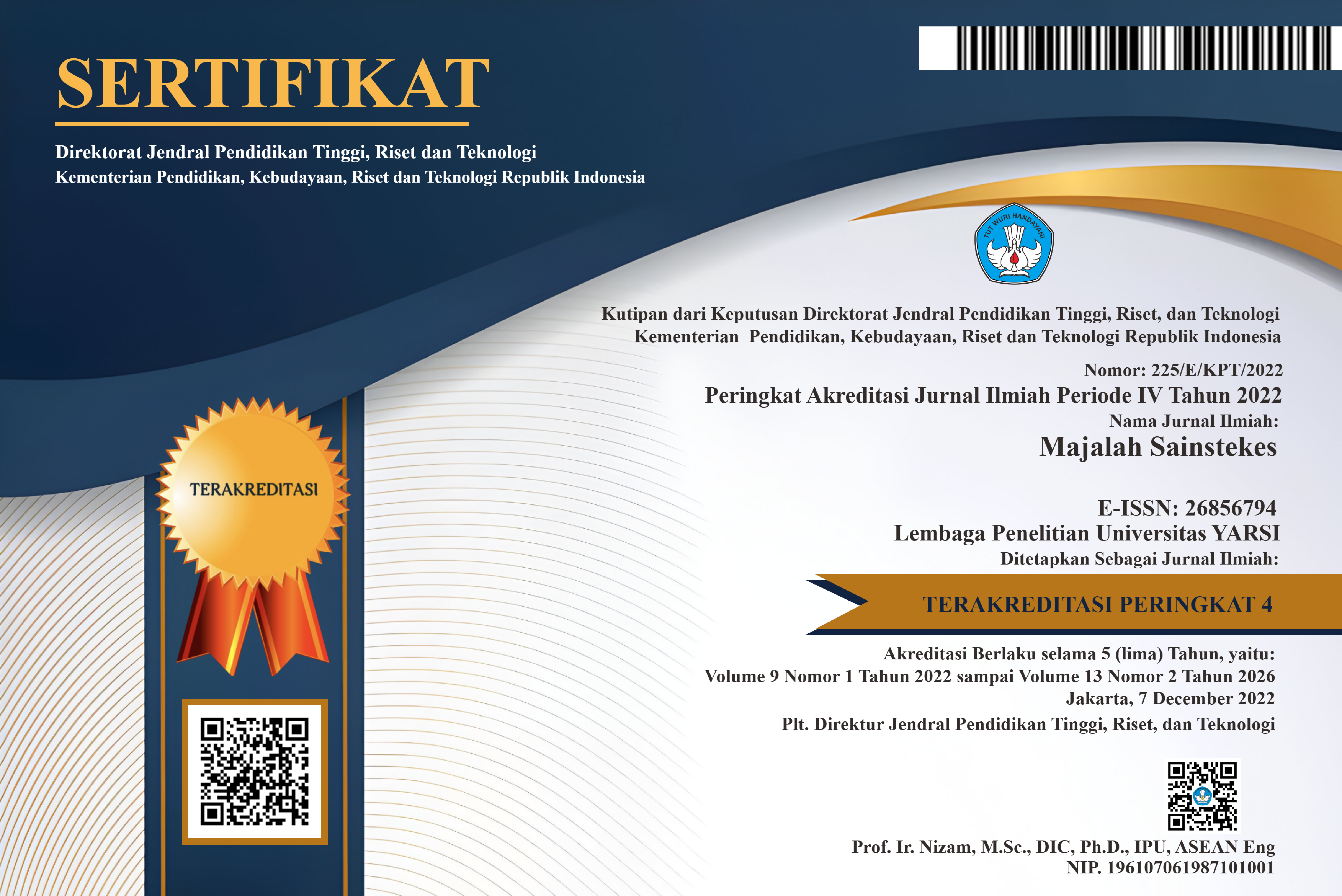Prevalensi Kelainan Refraksi pada Siswa SD Negeri 09 Pagi Tanah Tinggi Jakarta Pusat
Keywords:
Refractive examination, refractive disorder, elemantary school studentAbstract
Based on survey results of the Ministry of Health of the Republic of Indonesia reported in 1996 the highest prevalence of eye disease is refractive disorder, which is 24.72%. An estimated 12 million children from 19 million children suffering from blindness have refractive disorders.The purpose of this study is to obtained the prevalence of refractive disorder in children of State Elementary School Tanah tinggi 09 Central Jakarta. Refractive examination was conducted on 103 children at SD Negeri 09 Tanah Tinggi with 7-12 years old using Snellen Chart, LEA Chart, Autorefractors meter and Streak retinoscopy and also given glasses correction with glasses supplied. The prevalence of refractive abnormalities has been obtained from the refractive examination.There were 103 children examined, 53 of them suffering from refractive disorder with 51,46%. From the 53 people, 47 people with 88,68% diagnose with myopia simplex and 6 people with 11,32% was diagnose with Astigmatisme Myopia Compositus. Prevalence of refraction disorder based on Degrees of myopia, we found 46 people with low myopia (less than 3.00 Diopter), moderate (3 - 5 Diopter) and 2 people with high myopia (more than 6 Diopter) Diopters). The prevalence of Refractive Abnormalities in children at SD Negeri 09 Tanah Tinggi is quite high at 51.46%.References
American Optometric Association. 2006 Optometric Clinical Practice Guideline Care of The Patient with Myopia, reviewed 2006. Page 3-8.
Canadian Association of Optometrist (CAO). Work Life Balance. Royal Center Vancouver: Canadian Association of Optometrist. 2010.1-4
Curtin B.J. The Myopia.Philadelpia Diether S. Gekeler F. dan Schaeffel F. Change in Contrast Sensitivity Induced by Defocus and Their Possible Relations to Emmetropization in The Chikcen. Invest Ophthalmol Vis Sci.2001.42: 3079-9.
Dirani M, Chambulain M, Shekar SN, Katz J, Rahi JS, Newman DK, Thylefors B. Heritability of Refrative Error and Ocular Biometic: The Gene in Myopia (GEM) Twin Study.Opthalmology and Visual Science. 2008.49(10): 4336-433.
Handayani AT,Supradnya IGN, Pemayun-DCI. 2012. Characteristic of pasients with refractive disorder at Eye Clinic of Sanglah General Hospital Denpasar,Bali-Indonesia. Periode of 1st January – 31st December 2011. Bali Medical Journal (BMJ); 1 (3) page 101-107.
Hutahuruk M. 2009. Hubungan Antara Pengetahuan Dengan Sikap Orangtua Tentang Kelainan Refraksi Pada Anak. [Skripsi]. Semarang: FK Universitas Diponegoro.
llyas S. Penuntun Ilmu Penyakit Mata. Edisi ke-3. Jakarta: FK UI. 2006.64-88.
Morgan IG. The Biological Basis of Myopic Refractive error. Clin Exp optom.2003.86(5): 276-88.
Mutti O, Mitchell L,Moescheberger ML, Invers RQ, Orsoni JG. Parental myopia, Near Work, School Achievement and Children’s Refractive Error. Investigative Opthalmology and Visual Science. 2002.43:12.
Riset Kesehatan Dasar (Riskesda). 2013. Badan Penelitian Dan Pengembangan Kesehatan Kementerian Kesehatan RI
World Health Organization (WHO). 2013. Universal eye health: a global action plan 2014-2019.
Wu HM, Seet B, Yap EP, Saw SM, Lim TH, Chia KS. Does education explain ethnic differences in myopia prevalence? A population-based study of young adult males in Singapore. Optom Vis Sci. 2001 Apr;78(4):234-9.

 Saskia Nassa Mokoginta
Saskia Nassa Mokoginta












